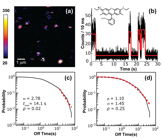Reports: UNI650873-UNI6: Probing Heterogeneous Electron Transfer Processes in Next-Generation Photovoltaics Using Single-Molecule Spectroscopy
Kristin L. Wustholz, PhD, College of William and Mary
With support from the ACS Petroleum Research Fund, my students and I have pursued two strategies toward the goal of characterizing model next-generation solar cells: (1) measuring heterogeneous ET processes in dye-sensitized solar cells (DSSCs) using single-molecule spectroscopy and robust statistical analyses, and (2) synthesizing model plasmon-enhanced DSSCs and probing plasmon-enhanced fluorescence.
In the first approach, single-molecule blinking is used to characterize the distributions of ET dynamics of dye sensitizers on TiO2. Blinking is characterized as random switching between on and off periods under continuous laser illumination due to the population and depopulation of emissive and non-emissive states. To characterize the ET kinetics in DSSCs, we measured the blinking dynamics of rhodamine B (RB), rhodamine 6G (R6G), 5-carboxy-rhodamine (5-ROX), and rhodamine 123 (R123) molecules on glass and TiO2 nanoparticle substrates. The series of xanthene dyes possess different structural motifs for binding to TiO2 as well as a range of thermodynamic driving force values. Blinking dynamics are quantified by constructing cumulative distribution functions of emissive (on) and non-emissive (off) events. Maximum likelihood estimation (MLE) methods and quantitative goodness-of-fit tests based on the Kolmogorov-Smirnov (KS) statistic are used to establish the best fit to the photophysical data. The on-time distributions for rhodamines on TiO2 are fit by power laws, but only for emissive durations that last longer than ~ 0.7 s. Furthermore, large variations in the power-law exponents are observed when using least-squares fitting as compared to the combined MLE and KS-test approach. The off-time distributions for molecules on TiO2 and glass are not consistent with power laws and are instead well represented by log-normal distributions.
Figure 1 presents the probability distributions of non-emissive events for R6G on TiO2 – showing the shortcomings of the conventional power-law fit. To understand the origin of these power-law and log-normal distributions, we modeled single-molecule blinking dynamics using Monte Carlo simulations based on a three-level system with the rate constants for population and depopulation of the non-emissive state being log-normally distributed. In this framework, the rate constants for forward and back ET are log-normally distributed, consistent with a Gaussian distribution of activation energies. Using this approach, we demonstrated that the ET kinetics on dye-sensitized TiO2 are complex and not always consistent with multi-exponential or power-law distributions as previously reported. Our observations suggest that these variations relate to the distribution in ET rates among various sites on the TiO2 nanoparticle film, though experimental and modeling studies are underway to test this hypothesis. The on-time and off-time distributions are sensitive to the substrate as well as the chromophore. Work is currently underway to understand the impact of covalent attachment on TiO2on the distributions of ET dynamics.
Figure 1. (a) Fluorescence image from 10-9 M R6G spun coat on TiO2; (b) Blinking dynamics of a single R6G molecule on TiO2; (c) back ET dynamics are not well represented by a power law (red dashed line) since the goodness-of-fit value is insignificant (p = 0.02); (d) back ET dynamics are instead consistent with a log-normal distribution (red dashed line).
Another strategy to improve DSSC efficiency is to reduce device thickness while maintaining optical absorption via the introduction of plasmonic nanostructures. We use plasmon-enhanced fluorescence spectroscopy to probe the photophysics of sensitizers in proximity to individual metal nanoparticles with applications to plasmon-enhanced DSSCs (PEDSSCs). During the funding period undergraduates successfully synthesized silica-coated Ag nanoparticles (SCNPs) with shell thicknesses ranging from 9.1±2.5 nm to 51±4 nm using a procedure adapted from the literature. The fluorescence enhancement near individual metal nanoparticles is investigated by coating SCNPs of various shell thicknesses with the fluorophoreRB using spin coating. Next, a combination of transmission electron microscopy (TEM) and fluorescence measurements are utilized to measure the impact of nanoparticle structure, size, and shell thickness (i.e., distance between dye and metal), on fluorescence enhancement.
Figure 2 presents correlated TEM and fluorescence microscopy measurements of SCNPs coated in 10-4 M RB. This representative data reveals a distribution of particle geometries and corresponding fluorescence enhancements (i.e., average enhancement is 2.9±1.0) in the sample. In particular, the monomer (particle 1) exhibits less fluorescence enhancement than the nearby dimer (particle 2), consistent with the formation of an EM "hot spot". These preliminary results demonstrate that single-nanoparticle spectroscopy is uniquely suited to study the impact of nanoparticle structure on EM enhancement in PEDSSC materials. Current work is underwayto probe the distance dependence of fluorescence enhancement near individual metal nanoparticles using this approach.
Figure 2. TEM micrographs (left) and corresponding (right) false-colored plasmon-enhanced fluorescence image of three SCNPs with 20-nm thick shells coated in 10-4 M RB via spin coating.
Career Development
Financial support from the ACS PRF been used to support 8 undergraduate students and 1 M.S. student at the College of William and Mary. Receiving the ACS PRF UNI grant has had a profound impact on my career as well as the intellectual development of a total of 14 undergraduate researchers since 2010. In addition to supporting basic research and purchasing supplies, this grant made possible paid summer research opportunities for several students as well as travel support to present our findings to the photochemistry and solar energy communities. As a result of these combined efforts, we recently published a manuscript in J. Phys. Chem. C. Three students on ACS PRF grant support who have graduated from my group (Garakyaraghi 2013, Blake-Hedges 2013, Ogata 2014) are now enrolled in Ph.D. programs in chemistry.













